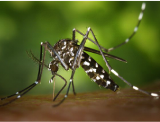Here in the U.S., mosquitoes are seen as pesky nuisances whose sting is blunted by our hermetically sealed lifestyles -- we live inside air conditioned homes with screens on the windows that protect us from their annoying bites. But in hotter tropical climes, especially in overcrowded mega-cities without adequate sanitation in Africa, Asia and South America, the tiny critters are airborne angels of death, delivering payloads of lethal pathogens that sicken half a billion people and claim at least a million lives annually.
Intriguingly, the migratory patterns of these insects provide a unique window into the effects a warming planet has on ecosystems, according to a PLOS ONE study, part of a new PLOS "Ecological Impact of Climate Change" research collection. This study, conducted by scientists at Suffolk County Vector Control in New York, the Pennsylvania Department of Environmental Protection, Mercer County Mosquito Control in New Jersey, and the Center for Vector Biology at Rutgers University, looked at how climate change will expand the range of one particularly deadly mosquito, the Aedes albopictus, in the Northeastern United States over the coming century, and the potentially grave implications of this shift in the mosquito populations for public health.
Deadly Asian Tiger Mosquito Thrives in a Warmer, Wetter Environment

The Aedes albopictus is a highly aggressive species that is also known as the Asian tiger mosquito because of its black and white stripes. Changes in the climate -- milder winters, wetter and earlier springs, and greener environments because of more rainfall -- have enabled the Aedes albopictius to breed faster, increase in numbers and expand their range into newly warming ecosystems. In the quarter century since their arrival here, the bugs have invaded 36 states, and have gradually migrated eastward throughout the south and eastern U.S., with a slow but steady northward expansion until they established a beach head on Long Island in New York in 2004. But researchers say the mosquito populations didn't really take off until five years later, in 2009, and by the following year, they had a firm foothold in Suffolk County. "This is a mosquito that doesn't fly very far," says Dr. Ilia Rochlin, an entomologist with Suffolk County Vector Control and Adjunct Professor at the Center for Vector Biology, Rutgers University. "But because it has this ability to hitchhike in containers, it gets moved around by people."
"It's often very difficult to document the effects of climate change on biological systems," says Dominick Ninivaggi, Superintendent of Suffolk County Vector Control in New York. "There are not very many animals where there are ongoing surveillance systems, and very few organisms are sampled systemically in that widespread of an area. The mosquito control program is serving a sentinel function in documenting the effects of climate change."
The bug has what researchers call a "high disease vector potential" because it bites all day long, from morning until night, and is an urban dweller with a special affinity for humans. Plus, the efficient pest can spread a number of disease-causing pathogens, and transmit more than 20 illnesses, including West Nile fever, dengue fever, yellow fever, two types of encephalitis and chikungunya, a particularly nasty infection that is endemic in Southeast Asia and has stricken thousands in that region with severely debilitating symptoms, including agonizing joint pain, fever, headache, fatigue, nausea, and vomiting.
"The tiger mosquito has been in southeastern U.S. for some years and we have yet to see any of these diseases take off," says Rochlin. "But that could just be a matter of luck and it may need just the right set of circumstances."
The invasive insects were introduced in the U.S. in 1985 when they most likely were stowaways inside recycled tires imported from Japan to Texas. "They're the classic container breeders," says Ninivaggi. "They lay their eggs in a container that might be dry and wait for the container to flood, and then the eggs hatch. It's a good strategy for hitchhiking. Those dormant eggs can sit for a long time -- at least a year -- which is certainly long enough to go from Japan to Houston."
How Do Scientists Know What They Know?
To make their predictions, the researchers used CO2 emissions scenarios and temperature increases based on projections from the Intergovernmental Panel on Climate Change. They also used Aedes albopictus surveillance databases from three states (Pennsylvania, New Jersey, New York) to determine known geographic locations, and then factored in such variables as projected winter temperatures and precipitation, which are the most critical climatic factors limiting growth and distribution of the mosquitoes, in order to model the future expansion of the insects in the northeastern U.S.
In the next two decades, the land area the mosquitoes cover will increase from 5 percent to 16 percent, according to the study's findings. By the end of this century, with winter temperatures in the northeastern US expected to rise by between 1.7 degrees Celsius to 5.4 degrees C (about three degrees Fahrenheit to nine degrees Fahrenheit), their natural habitat should expand to cover up to 49 percent of the land in the northeast. Right now, about one-third of the total population of 55 million people in the northeastern U.S. live in areas where the tiny insect has taken up residence, but that number is projected to double, to 60 percent, by the end of the century, when the mosquito is expected to infest all the major cities on the Atlantic Coast, making over 30 million people who live in these areas vulnerable to locally acquired infections.
"The problem is only going to get worse and we have a great deal of difficulty controlling them because they have these tiny breeding places," says Rochlin. "We can't go into everyone's backyard and remove all the paper cups, toys and bird baths to get rid of them. We need to be vigilant."
![]() This post is part of the PLOS BLOGS "Conversation on Climate Change."
This post is part of the PLOS BLOGS "Conversation on Climate Change."
